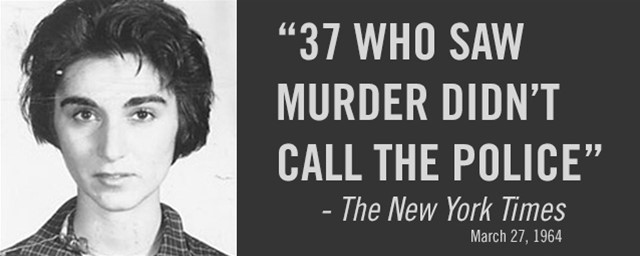
After the murder of Kitty Genovese there were two very different news stories that we have looked in to.
Kitty Genovese was a New York City woman who was stabbed to death outside her apartment building on 13th March 1964.
According to the New York Times it was “a scene of indifference from the neighbourhood who failed to come to Genovese’s aid”.
Twenty-eight year old Kitty Genovese was walking from her car to her apartment building after finishing work at a bar at around 3am. She parked her car around 100 yards away from her apartment and began to walk towards the entrance. Murderer Winston Moseley approached her, when she ran from him towards the entrance of her apartment he chased her and stabbed her twice in the back.
Genovese screamed and cried out for help, and Moseley ran away. Several of her neighbours in their apartments heard her screaming and crying, but no all of them knew that it was a cry for help.
![]() But why didn’t the witnesses come to Kitty Genovese aid?
But why didn’t the witnesses come to Kitty Genovese aid?
It is said that neighbours sat at their windows watching the attack happen for thirty minutes but in other news stories this isn’t the case.
The other news story told us that thirty-seven witnesses supposedly saw or heard the attack but did not call the police. In total there was thirty-eight witnesses. One of the thirty-eight called the police.
There were also problems as those who did see the attack didn’t see the whole attack. The murder occurred in two attacks. During the first attack on the street, some neighbours did have a view of what was happening out on the street. But Genovese then moved into a stairwell of a building, which unfortunately obstructed the view of the second attack.
Many people did intervene even though it was said that people didn’t. Whilst the first attack when a neighbour, Robert Mozer yelled from his window for the attacker to “Let that girl alone!” Apparently one witness even sat by her side whilst help came.
We believe this is what caused Psychologists to look into the bystander effect, also known as “Genovese syndrome”.
Social psychologists Bibb Latane and John Daley popularized the concept of the bystander effect following Kitty Genovese’s murder. The bystander effect occurs when the presence of others discourages individuals from intervening in an emergency situation.

Most recently there has been another case similar to the Kitty Genovese case. On 24th April 2010, a thirty one year old homeless man named Hugo Tale-Yax was stabbed to death police believed he was billed when trying to stop an attack on a woman.
At least twenty people walked past the dying man lead on the pavement for nearly an hour.
Some of the public turned their heads to look, others stopped to gawk. One man lifts Tale-Yax’s body, which exposed what appeared to be blood on the pavement underneath him, before putting the body back down and walking away.
We’ve looked in to many cases and we agree with the bystander effect.
If you stop and think back to situations in your life we bet you have walked past a situation and when you think back, you feel that maybe you should have stopped.
Not something as serious as murder but smaller scale situations in life which still link to the bystander effect.

References
Kulis, J.V. (2004) The Beauty of Intervention. Professional Safety, 49 (9), 41-43. – Date Accessed 08/12/2015
http://www.citylab.com/crime/2015/08/the-murder-of-kitty-genovese-and-the-myth-of-the-heartless-city/400622/ – Date Accessed 11/12/2015
http://www.psychology.about.com/od/socialpsychology/a/bystandereffect.html – Date Accessed 08/12/2015
http://www.psychologytoday.com/basics/bystander-effect – Date Accessed 08/12/2015
http://study.com/academy/lesson/defining-the-bystander-effect-kitty-genovese-murder-research-by-latane-and-darley.html – Date Accessed 11/12/2015
I think the bystander effect does have an effect on us all at some point. Do you think maybe it would effect different people to different levels ? For example would an outwardly confident person who has a positive self image and confidence in themselves be less likely to be effected than a more shy and less confident person, who may be more likely to go with the crowd to stay un-noticed ?
LikeLike
i believe the bystander effect has a similar effect on everyone as it only appears to happen in larger groups. i also believe that if you are shy because you are anxious in social groups you could be effected more as the anxiety could overwhelm you.
LikeLike
Very interesting blog !
I have no idea what is causing people to walk away..is it fear ? I have never ever been in a situation as extreme as that one and I don’t know how I would react but I think I would do my best to help! Have you ever been a witness of anything like that? if you have how did you react, what did you do ??
LikeLike
The bystander effect teaches us that people are more likely to help if they are on their own than in a group as they dont want to take responsibility. i have personally never been in this situation but from what i have learnt i would hope i would help whoever needed it.
LikeLike
Does the individuals flight or fight response determine whether they confront a situation? I believe so.
Also, the individuals attitudes to situations may affect whether or not they help, as previously mentioned, if you have a positive self image and believe yourself to be of service to others, you may be more likely to help than a person who considers themselves shy and unable to help.
Stereotypes and prejudices I also believe play a part. If you had derogatory beliefs about homeless people, would you help a homeless person in need? Studies have shown that people are more likely to help someone who falls with a briefcase and a suit on than they would someone who looked dishevelled and walked with a limp. Shocking, but true. Maybe as a society we all need to make ourselves readily available to help our neighbour regardless of our beliefs.
LikeLike